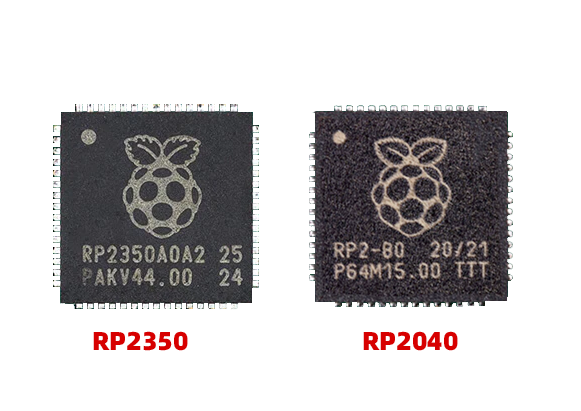
Support Team
Feedback:
support@nextpcb.comThe RP2350 is a new microcontroller released by Raspberry Pi Ltd, continuing the company's focus on low-cost, high-performance solutions. Announced on August, 2024, this microcontroller provides a new option for developers and embedded system designers. The release of the RP2350 marks Raspberry Pi's expansion into the microcontroller market, particularly for embedded systems that require low power consumption and broad application support, showcasing the chip's vast potential.
Image source: raspberrypi.com
The RP2350 inherits Raspberry Pi's immense influence in the developer community and offers significant improvements in several areas:
The RP2350 is equipped with two ARM Cortex-M33 cores and two Hazard3 RISC-V cores (RV32IMAC+). These cores provide powerful processing capabilities for embedded development, enabling complex tasks while maintaining low power consumption. Only two cores are active at any given time, ensuring energy efficiency.
The RP2350 is equipped with 520KB of SRAM, supporting 10 concurrently accessible memory banks. This allows for efficient memory management and reduced latency. For persistent storage needs, the RP2350 also offers up to 2MB of optional QSPI NOR flash (available only in RP2354 versions).
The RP2350 integrates a wide range of peripherals, suitable for various embedded applications, including:
The RP2350 includes a hardware SHA-256 accelerator, enabling faster cryptographic operations. Additionally, it offers a hardware random number generator (TRNG) and OTP storage options, providing enhanced security for developers.
The RP2350 comes in multiple versions to meet different application requirements:
These variant choices allow developers to select the appropriate model based on specific needs, ensuring compatibility and optimal functionality.
Raspberry Pi Ltd's RP2350 and RP2040 microcontrollers are designed for different types of embedded applications, with the RP2350 offering more advanced features compared to the RP2040. Below is a detailed comparison of both microcontrollers across various aspects such as processing power, connectivity, memory, power management, security features, and suitable application scenarios.

● RP2040: Features dual ARM Cortex-M0+ cores, with a maximum clock speed of 133 MHz. The Cortex-M0+ cores are low-power, efficient processors suited for simpler embedded applications.
● RP2350: Equipped with dual ARM Cortex-M33 cores and dual Hazard3 RISC-V cores (only two cores active at any time). The Cortex-M33 cores provide higher processing power, supporting hardware encryption, DSP, and floating-point operations, while the RISC-V cores offer the benefits of an open architecture.
● RP2040: No onboard flash memory. It relies on external QSPI flash memory (up to 16 MB) to store programs and data. It has 264 KB SRAM for system and data storage.
● RP2350: Provides 8 KB OTP (One-Time Programmable) memory, with an optional 2 MB internal QSPI NOR flash. It also has 520 KB SRAM, which is suitable for more complex applications requiring larger storage.
● RP2040: Offers 30 GPIO pins (4 of which can be used as analog inputs), supports 2 UART, 2 SPI, 1 QSPI (1/2/4-bit), and 2 I²C controllers, and is equipped with 8 PIO state machines.
● RP2350: Offers 30 GPIO pins (RP2350A) or 48 GPIO pins (RP2350B), with up to 8 analog input pins (RP2350B). It supports 2 UART, 2 SPI, 2 QSPI (1/2/4-bit), 1 HSTX (high-speed serial transmit) controller, and 12 PIO state machines, providing more flexibility and external peripheral connections.
● RP2040: Features a 4-channel 12-bit SAR ADC, capable of reading analog signals, with an integrated temperature sensor.
● RP2350: Provides a 4 or 8-channel 12-bit SAR ADC (depending on the package), with an additional channel connected to an internal temperature sensor, offering greater analog input capabilities.
● RP2040: Dual Cortex-M0+ cores with a maximum clock speed of 133 MHz, designed for low-power applications.
● RP2350: Dual Cortex-M33 cores and dual RISC-V cores, with a maximum clock speed of 150 MHz, offering higher performance, particularly for applications requiring hardware acceleration.
● RP2040: Includes an LDO (Low Dropout Regulator) to generate core voltage and two PLLs (Phase-Locked Loops) to generate USB and core clocks.
● RP2350: Also includes an LDO and two PLLs, providing robust power management for core and USB clock generation.
● RP2040: Lacks hardware acceleration features.
● RP2350: Features a hardware SHA-256 accelerator and a hardware random number generator (TRNG), providing hardware support for encryption and security applications.
● RP2040: Supports 1 USB 1.1 controller (Low Speed & Full Speed) with a maximum data transfer rate of 12 Mbps.
● RP2350: Supports 1 USB 1.1 controller, supporting both Low Speed and Full Speed data transfer, with more robust peripheral support and flexibility.
● RP2040: As a low-power, cost-effective microcontroller, RP2040 is suitable for applications in education, DIY projects, and IoT devices, where external flash and flexible peripheral connectivity are essential.
● RP2350: Due to its higher processing power, larger memory, and hardware acceleration capabilities, RP2350 is better suited for more complex applications, such as industrial automation, sensor data acquisition, and high-speed data processing.
The RP2040 is ideal for low-power, cost-effective applications, offering basic peripheral support and memory suited for educational projects, simple embedded systems, and IoT devices. In contrast, the RP2350 provides greater performance, larger memory capacity, more extensive external peripheral support, and enhanced security features, making it better suited for advanced embedded systems, industrial control, and encryption-based applications. Overall, the RP2350 surpasses the RP2040 in features and performance, making it more suitable for applications that demand higher storage, processing power, and security.
Both the RP2350 and RP2040 microcontrollers are excellent options, but they cater to different levels of development and use cases. If you are just starting out with embedded systems or working on relatively simple projects, the RP2040 is an excellent choice, offering good performance at a very affordable price.
However, for developers working on more complex systems, IoT applications, or projects requiring more powerful processing, better security features, and more peripherals, the RP2350 is the better option. Its superior processing power, increased storage, and enhanced security features make it the ideal choice for advanced embedded applications.
With its low power consumption and high efficiency, the RP2350 is widely used in various industries. Below are the key application areas:
RP2350's low power and high performance make it an ideal choice for Internet of Things (IoT) applications, such as smart home systems and environmental monitoring. With its powerful processing capabilities and various connectivity options, the RP2350 can support a wide range of sensors, actuators, and communication modules, making it perfect for smart home automation and industrial IoT (IIoT) systems.

RP2350's strong processing power and multiple I/O interfaces make it highly suitable for industrial control and automation systems. Whether in production line equipment control, robotics, or data acquisition systems, the RP2350 provides a reliable solution. Its 24 PWM channels and abundant ADC interfaces enable precise control of motors, sensors, and other devices.

As an open-source hardware platform, the RP2350 offers a powerful learning environment for developers, students, and hobbyists. With support for languages like MicroPython, Rust, and C++, RP2350 is a great choice for embedded systems education and experimentation. Its low cost also makes it highly accessible for use in schools, laboratories, and personal projects.

RP2350 is also applicable in consumer electronics such as smart speakers, health monitoring devices, and wearable gadgets. Its low power consumption and high performance are crucial for meeting the demands of these devices in terms of performance and battery life. Coupled with its rich set of interfaces, it can integrate with displays, sensors, and other components to create feature-rich consumer electronics products.

As the automotive industry moves towards greater automation and smart features, RP2350 can be employed in the development of in-car devices. It can power in-vehicle infotainment systems, automotive sensors, and control systems. With its PWM and ADC capabilities, RP2350 is well-suited for motor control and sensor data acquisition in automotive applications.

The RP2350 supports multiple programming languages, including C, C++, Rust, MicroPython, and CircuitPython, enabling developers to use familiar tools for development. For hardware design, the RP2350 is compatible with several development platforms and debugging tools, with extensive documentation available to help developers get started quickly.
● RP2350 Datasheet: A detailed overview of RP2350's technical specifications and performance characteristics. https://datasheets.raspberrypi.com/rp2350/rp2350-datasheet.pdf
● RP2350 Product Brief: Learn more about the market positioning and core advantages of the RP2350. https://datasheets.raspberrypi.com/rp2350/rp2350-product-brief.pdf
● Hardware Design with RP2350: Access comprehensive guidelines for hardware design using the RP2350 microcontroller. https://datasheets.raspberrypi.com/rp2350/hardware-design-with-rp2350.pdf
The RP2350 is a microcontroller designed for low-cost, high-performance applications, suitable for use in embedded systems, IoT devices, smart homes, and more. By offering powerful processing capabilities, a wide array of peripherals, and high flexibility, the RP2350 is an ideal platform for developers. If you're looking for a high-performance, cost-effective microcontroller, the RP2350 is an excellent choice.
With the information provided above, you should now have a better understanding of the RP2350's features and its applications. If you're ready to start your project, be sure to check out the documentation linked above to dive deeper into RP2350's technical details and design guidelines.
NextPCB Accelerator #4 - Explore Embedded AI with ESP32-S3 and Free PCBA Prototypes
NextPCB Accelerator #1 - Jumpstart Innovation with RP2040 and Free PCBA Prototypes
Save $200 on Professional Turnkey PCB Assembly from HQ NextPCB
FREE Functional Testing for your Prototype PCBA with HQ NextPCB (blog)
Still, need help? Contact Us: support@nextpcb.com
Need a PCB or PCBA quote? Quote now
|
Dimensions: (mm) |
|
|
Quantity: (pcs) |
|
|
Layers: 2 |
Thickness: 1.6 mm |
|
|
|